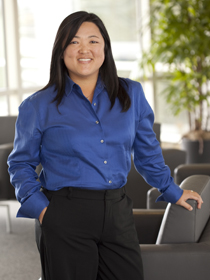Alumni distinction
Doctoral candidate examines how mobile technology may enhance the value and quality of health care

Doctoral candidate Katherine Kim
Editor’s note: As of June 2014, Katherine Kim is a graduate of the School of Nursing. This story was first published in spring 2012 during Katherine Kim's second year of a four-year doctoral program. Since then, her research in mobile health technology received recognition from numerous national and regional organizations including the Healthcare Information and Management Systems Society Northern California Chapter, the National Science Foundation and the Agency for Health Research and Quality.
Emerging and new technologies, such as cell phones, social media and data management systems, could provide solutions to complex health-care issues. Betty Irene Moore School of Nursing doctoral candidate Katherine Kim discovers how such technology can improve the quality, safety and cost-effectiveness of health care.
For her dissertation, Kim’s research focuses on the impact of mobile technology and social media on consumers’ ability to manage their health and partner with their providers to do so. She is studying iN Touch, a mobile platform to track daily living for low-income, obese and depressed youth.
With funding from Robert Wood Johnson Foundation’s Project HealthDesign, Kim and her colleagues customized an iPhone/iPod Touch application that tracks food, exercise, mood and socialization and supports communication between the participant and a health coach. Additionally, the program includes weekly summary reports that are integrated into the providers’ electronic health records so the information is available to all providers.
Kim said preliminary data show those who used the product achieved positive results including improved waist measurements and self-confidence in managing health.
The project is one example of how Kim sees technology improving health for all.
“The role of information and management systems in health care has changed dramatically in a short time period,” Kim said. “Now, information systems are embedded in the workflow and have the potential to reach into the community and consumers’ homes. The impacts include changing roles of providers, healthcare workers and consumers.”
Kim, in her final year of the Nursing Science and Health-Care Leadership Doctor of Philosophy Degree Program, said she looked for years to find a way to merge her passion to explore the solutions provided by technology with scientific research.
“For 15 years, I’ve explored doctoral programs,” she said. “But the focus was always too narrow, too focused on one discipline or profession. I am interested in research that demonstrates the application of technology, in a broad perspective, can improve health.”
Those perspectives, she said, exist at the Betty Irene Moore School of Nursing. Over the past four years, Kim emerged as a leader within health technology. She realized a number of achievements including co-founding the Interprofessional Health Informatics Student Special Interest group at UC Davis Health and receiving a $5,000 Northern California Health Information and Management Systems Society scholarship. Kim published several articles in journals such as Medical Care and Nursing Outlook. In addition, she presents and moderates at conferences and workshops around the country.
“I’ve never had this degree of professional success before and I attribute that greatly to the Betty Irene Moore School of Nursing,” Kim said.
“Being here, learning in this group environment fuels my enthusiasm. I am confident that I can be a part of effective change.”
With master’s degrees in both public health and business administration, Kim is one of the few doctoral candidates at the school who is not a registered nurse. Kim teaches at San Francisco State University while also pursuing her doctorate. Prior to that position, she worked as a clinic manager. In that role, she led a team that streamlined and automated health-records technology and processes for two merging medical groups. Kim also founded her own company to automate referrals and processes at hospitals. She and her team created a product that linked primary-care physicians, clinics and hospitals.
“Technology should not reinforce old silos. It needs to be interprofessional,” Kim said. “A team from a variety of backgrounds must identify how a particular product is going to solve a problem because the end product will be utilized by a variety of users. When the technology is effective for users, then it will enhance the value and quality of health care.”





